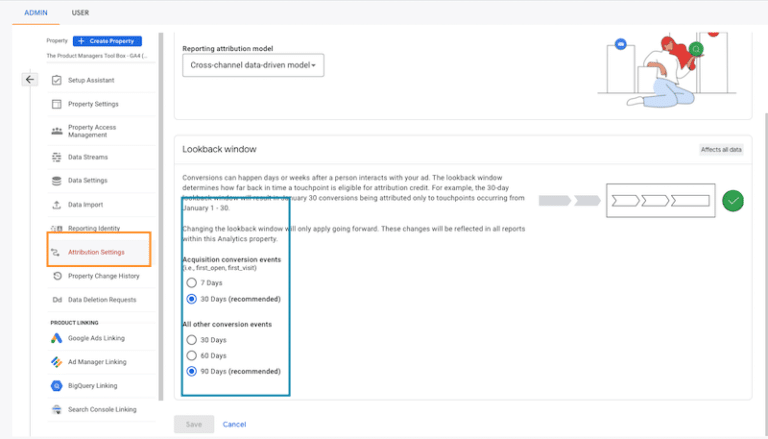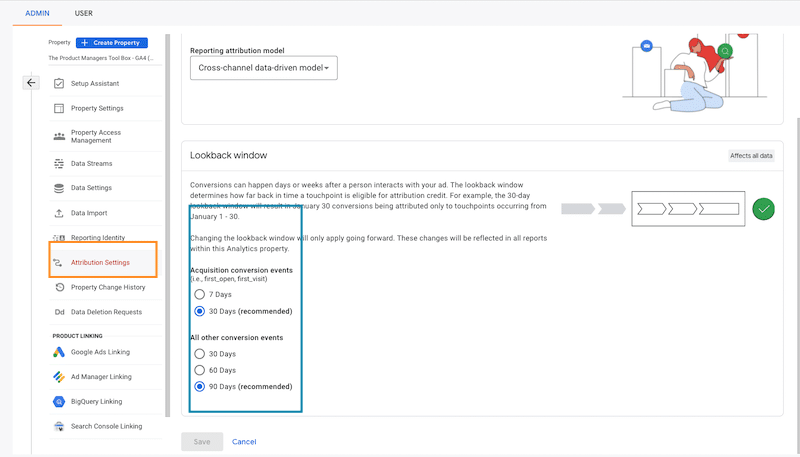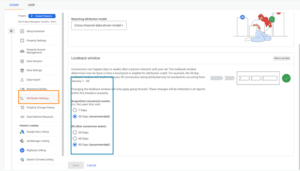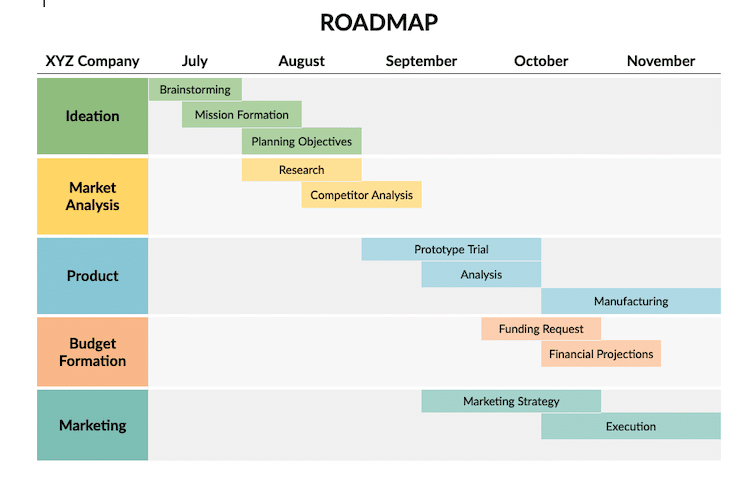If I had to explain why understanding attribution modeling in Google Analytics 4 is so important for product managers, I’d offer that historically, the “Last non-Direct click” attribution model core to Universal Analytics leads to a large redistribution of traffic into other channels that may have actually come back via Direct as a result of a “last interaction” model, which has an impact on judging the success of your product and the overall trajectory of your career.
As Google evolves its analytics tool, you need to should understand how the transition from last click interaction attribution to data driven attribution will impact the performance statistics associated with you product. Also, not knowing this inner working of Google Analytics 4 violates the use data commandment from our ten commandments of product management
However, you should be aware that Google’s data driven attribution is still a black box, but probably better than any other solution you can reasonably come up.

What is Data Driven Attribution
Data Driven Attribution (DDA) is an algorithmic model that takes into account each of the touchpoints observed for your website conversion events.
It then does some modeling (GA secret sauce) to assign credit to each channel. In GA3, DDA looked at the last 4 touchpoints to do this modeling, in GA4 that number goes up significantly to 50+ touchpoints, ensuring that all of your marketing efforts are taken into account when assigning credit.
- What about all the prior exposures to your brand?
- Did they convert solely on that last ad?
- What about the other ads they clicked on before it?
Attribution is the act of assigning credit for conversions to different ads, clicks, and factors along a user's path to completing a conversion.
An attribution model can be:
- A simple rule
- A somewhat more complex set of rules.
A super complex set of rulesAn algorithm that determines how the credit for a conversion is allocated to touch points on conversion paths.
At the time of writing, there are three types of attribution models available in the Attribution reports in Google Analytics 4 properties:
- The cross-channel rules-based models
- The Ads-preferred rules-based model
- The data-driven attribution.
Attribution Basics
A key to understanding attribution modeling in Google Analytics 4 is understanding how attribution used to be done, so let’s start off with a walk down attribution memory lane shall we?
Universal Analytics Attribution
In Universal Analytics, the “Last non-Direct click” model is the default model in all reports, except for multi-channel funnel reports, as well as Google Analytic 4’s User and Traffic attribution reports.
So I can guarantee that at least one of you is about to Google “Last non-Direct click”, so in the spirit of generosity, I’ll save you the trouble and explain it for you right here.
Last non-Direct click means that Google Analytics looks at the UTMs (source/medium) of the incoming session, and if it is anything other than direct, classify it to that channel.
Excuse Me, But What Is A UTM?
https://www.theproductmanagerstoolbox.com/?utm_source=blog&utm_medium=post&utm_campaign=analytics
The Good, The Bad & The Ugly of Last Click Attribution
The Good
- Long Term Benefit: Gives credit for the long-term effects of marketing campaigns.
The Bad
- GIGO: Increases the amount of “data” you have on known traffic sources, this data can be misleading, hard to interpret, or raise questions that you just can’t answer as you know how fucked up it can get, like did that user Suzy Q click on link in a Twitter post from 3 months, or are they just returning to the site directly? With last non-direct click attribution, we cannot answer that question.
The Ugly
- More Fodder For Useless Meetings & Presentation: Decreases the amount of traffic that is labeled “Direct” in reports while increasing traffic to known sources of traffic. This can give you more actionable data when putting together your marketing strategy. It can be much easier to react to data about the performance of your email, social, or cpc campaigns than to the performance of direct traffic.
Google Analytic 4 Attribution
- The first session gets attributed to the channel of Direct (direct /none),
- The second session will be attributed to Referral.
Working with Attribution Models
The secret to understanding attribution modeling in Google Analytics 4 is by getting your hands dirty and working through it on your own.
The best place to start this process is with Google Analytics 4’s model comparison tool that let’s compare Last non-direct click to DDA ( you can find it in the image below).
You’ll notice that the first column defaults to Cross-channel last click and the second channel defaults to Cross-channel data-driven. You can change this by clicking the drop down arrow to choose which model you are interested in or change from the default.
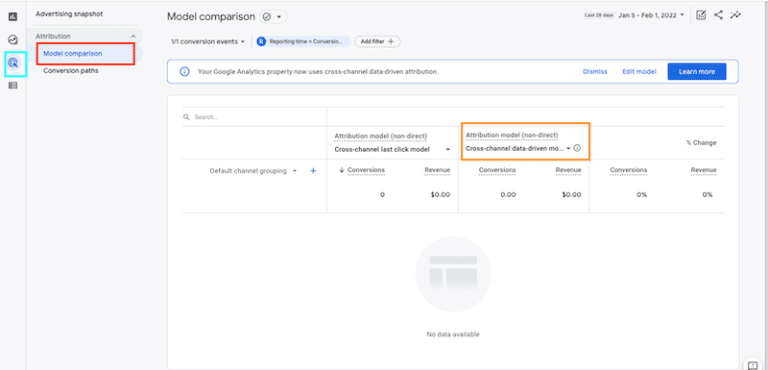
Reporting Attribution Settings
In the Attribution settings view, you can select from:
- Data-driven attribution
- Cross-channel rules-based models
- Ads-preferred last click model.

Data Driven Attribution
As we have previously said ad nauseam, Data-driven attribution uses account’s data to calculate the contribution of each click interaction associated with a conversion event.
It involves using machine learning algorithms to build models based on evaluation of both converting/non-converting paths, learning how different touch points impact conversion outcomes.
Cross-channel rules-based models
- Cross-channel last click: Ignores direct traffic and attributes 100% of the conversion value to the last channel that the customer clicked through before converting.
- Cross-channel first click: Gives all credit for the conversion to the first channel that a customer clicked.
- Cross-channel linear: Distributes the credit for the conversion equally across all the channels a customer clicked before converting.
- Cross-channel position-based: Attributes 40% credit to the first and last interaction, and the remaining 20% credit is distributed evenly to the middle interactions.
- Cross-channel time decay: Gives more credit to the touch points that happened closer in time to the conversion.
Ads-preferred model
What Happens When You Select An Attribution Model?
Now that you have a it of a clue as to how the different models function, use the “Reporting attribution model” dropdown to select which of the attribution model to use:
- to calculate conversion credit in your reports within your Analytics property,
- within the conversions reports of any linked Firebase projects.
Warning #1: Changing the attribution model applies to historical and future data.
Warning #2: Attribution model changes impact all reports using event-scoped traffic dimensions:
- Source,
- Medium,
- Campaign, and
- Default channel grouping.
This means there will be changes to the following metrics when used with event-scoped traffic dimensions:
- Conversions,
- Total revenue,
- Purchase revenue, and
- Total ad revenue.
This will impact both the Conversions details reports and Explorations.
Warning 3: User- and session-scoped traffic dimensions–such as Session source or First user medium–are unaffected by changes to the reporting attribution model.
Lookback Settings
As anyone who has worked in e-commerce knows, conversions take time. They can happen days or weeks after a person first interacts with your ad.
Use the lookback window to modify how far back in time a touch point is eligible for attribution credit.
The lookback window applies to all attribution models and all conversion types. A few things worth knowing:
- Changes to the lookback window apply going forward
- Lookback window changes will be reflected in all reports within your Analytics property.
- The default lookback window for acquisition conversion events is 30 days. You can switch to 7 days if you have different attribution needs.
- The default lookback window is 90 days for all other conversion events. You can also choose 30 days or 60 days.
